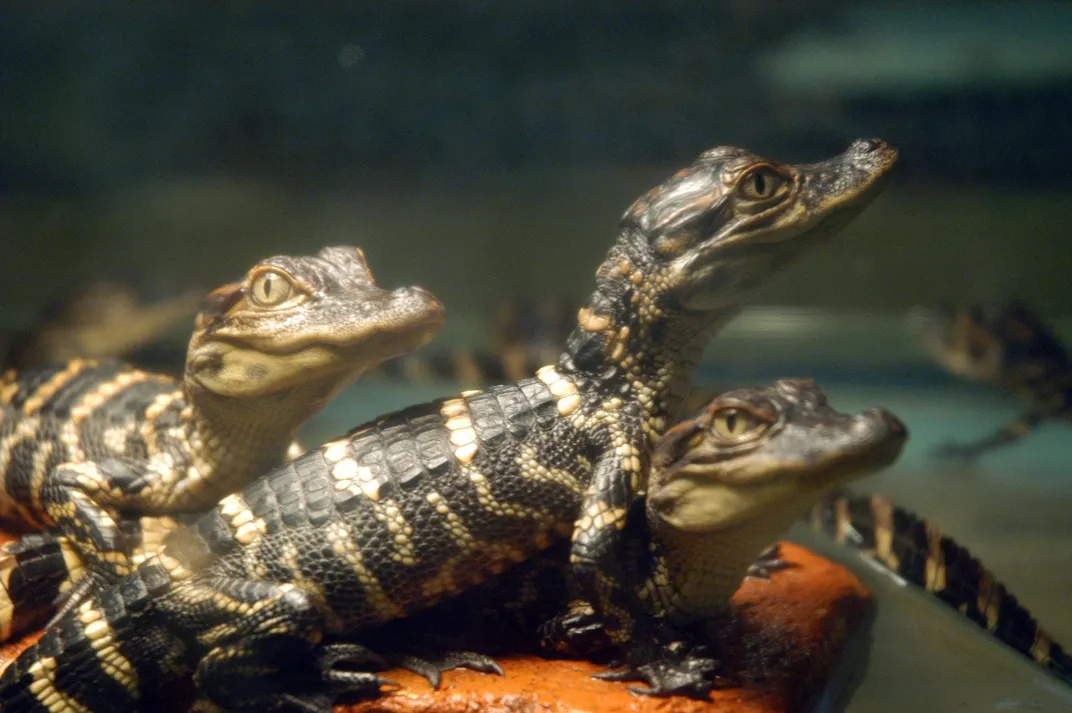Alligators Are Now the Largest Species Known to Regrow Severed Limbs
Young gators can sprout new tails that can reach up to nine inches, helping them survive through their juvenile years
/https://tf-cmsv2-smithsonianmag-media.s3.amazonaws.com/filer/0d/68/0d689d41-3a8f-4cf7-af5e-aea86178f2ff/7490658926_980418529f_b.jpg)
Small reptiles, like lizards, geckos and iguanas, are famous for being able to sprout new limbs if they lose a body part, like a leg or a tail. The regenerated limb usually isn't exactly the same as the original, but it's enough to give the critter a new leg up on survival.
Despite also being reptiles, little was known about whether or not alligators could regenerate their thick, massive tails. Gators can reach 15 feet in length and weigh up to 1,000 pounds, so regrowing a tail is no small feat. But in a surprising new discovery, scientists found that young American alligators can regrow their tails up to nine inches, or around 18 percent of their body length, reports Marika Gerken for CNN.
Kenro Kusumi, a biologist at Arizona State University, received a package that contained only a small, deformed alligator tail preserved in a pickle jar. The tail's tip was pronged and the scales were smaller than usual, reports Annie Roth for National Geographic.
Further analysis revealed that the tail had grown back after it was severed. Using high-tech imaging techniques and traditional dissection, the researchers found that the gators' tails regrew cartilage, connective tissue and skin instead of bone and skeletal muscle, reports CNN. The findings revealed that American alligators have more regenerative abilities that mammals, which mostly regrow nerves, skin and blood vessels, but less than lizards, which can sprout entirely, nearly perfect tails with skeletal muscle, reports National Geographic. Kusumi and his team analyzed three more tails from juvenile alligators and found further evidence that the tails could regenerate. Their findings were published in November in the journal Scientific Reports.
Regrowing limbs—especially alligator tails—isn't easy, so the investment has to be worth it in the long run.
"But what really surprised us about the alligator was that there was no regrowth of skeletal muscle," lead author Cindy Xu, a biologist who conducted this research while at Arizona State University, tells National Geographic. "The regrowth of tissue is very energetically expensive. If you’re putting all of your energy into regrowing a structure perfectly, you’re deviating energy away from other more essential processes such as developmental growth."

For a young gator, regrowing a lost tail "has obvious fitness benefits," Adam Rosenblatt, a biologist at the University of North Florida who was not involved in the study, tells National Geographic. He says that juvenile alligators are "on the menu for pretty much every predator out there." As such, they need a tail to help them elude predators and make it through their most vulnerable years.
This study also brings up new questions about how regeneration evolved in reptiles. Some dinosaurs—the ancestors of both alligators and birds—had the ability to regrow new limbs. The two lineages diverged around 250 million years ago, but alligators have retained the ability to regenerate while birds have not, according to a press release.
"Our finding that alligators have retained the cellular machinery to regrow complex tails while birds have lost that ability raises the question of when during evolution this ability was lost," Kusumi says in the press release. "Are there fossils out there of dinosaurs, whose lineage led to modern birds, with regrown tails? We haven’t found any evidence of that so far in the published literature."
Studying how reptiles regenerate their limbs could have implications for developing regenerative therapies for people living with arthritis or other injuries, reports Simone Jasper for the Miami Herald.
"We know that humans—who are incapable of regenerating—have the same cells and pathways being used to regenerate in these other animals," co-author Jeanne Wilson-Rawls, a biologist at Arizona State, tells CNN. "If this very large long-limbed animal has this ability, can we take advantage of this to help people who have lost limbs or burn victims who need skin regeneration?"
/https://tf-cmsv2-smithsonianmag-media.s3.amazonaws.com/accounts/headshot/rasha.png)
/https://tf-cmsv2-smithsonianmag-media.s3.amazonaws.com/accounts/headshot/rasha.png)